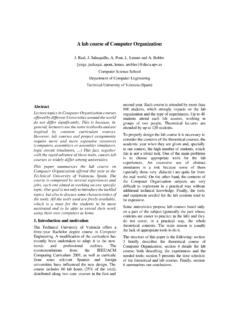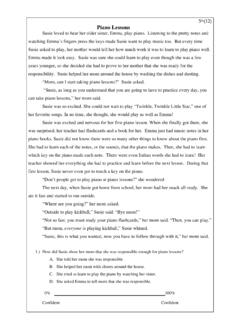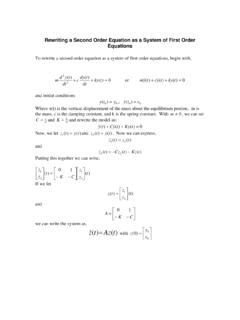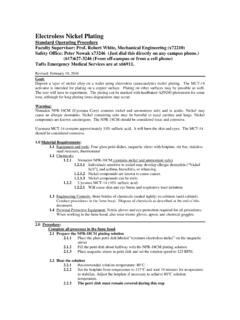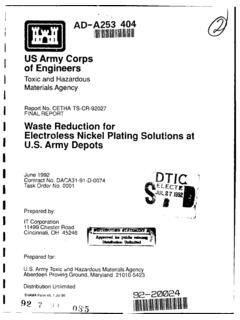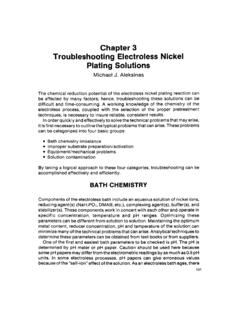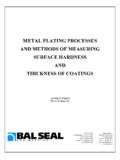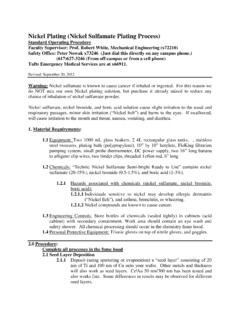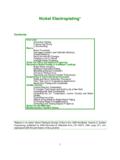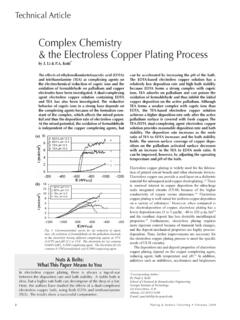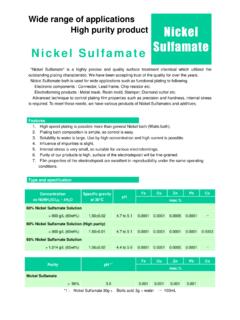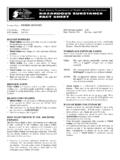Transcription of Electroplating - NC State University
1 NCSU Dept. of Chemistry Lecture Demonstrations Electrochemistry Electroplating Description: Electroplating is demonstrated by plating copper onto a stainless steel object. Materials: 1 M CuSO4 V battery Copper strip Connecting wires Stainless steel object Beaker 6 M H2SO4 nickel strip (optional) Silver strip (optional) Procedure: For large lecture halls, project demonstration using a document camera. 1. Prepare the plating solution by mixing 15 mL of 6 M H2SO4 with 250 mL of CuSO4. Clean the surface of the electrodes with steel wool prior to the demonstration. 2. Place the electrodes in the plating solution making sure that they do not touch. Using wires with alligator clips, connect the copper electrode to the positive terminal of the battery and connect the stainless steel electrode to the negative terminal of the battery.
2 After five minutes, disconnect the electrodes from the battery and remove the stainless steel object from the plating solution. After gently rinsing, the new copper surface is revealed. 3. The plating can be reversed by switching the battery leads on the electrodes. Discussion: In this demonstration, copper is plated onto the surface of a stainless steel object. Copper from the anode is oxidized to Cu2+ which is reduced at the cathode to form the solid copper plating . The copper sulfate solution serves as an electrolyte solution as well as the source of the Cu2+ to be plated on the cathode. H2SO4 is added as an additional electrolyte. Dilute HCl ( M) can be added to reduce anode polarization as noted in the Shakhashiri reference.
3 Anode Cu Cu2+ + 2 e1- Cathode Cu2+ + 2 e1- Cu NCSU Dept. of Chemistry Lecture Demonstrations Electrochemistry Safety: Wear proper protective equipment including gloves and safety glasses when preparing and performing this demonstration. Concentrated solutions of acids and bases (>2 M) can irritate the skin and cause burns. Vapors of concentrated acids are extremely irritating to the eyes and respiratory system. Disposal: The plating solution should be neutralized with a bicarbonate solution and disposed of in an aqueous waste container. Electrodes can be rinsed, dried and cleaned with steel wool. References: Shakhashiri, B. Z. In Chemical Demonstrations: A Handbook for Teachers of Chemistry; The University of Wisconsin Press: 1992; Vol.
4 4, p 212-223 (copper); 236-239 (silver). Seiglie, C. A. J. Chem. Educ. 2003, 80, 668. (determining NA from Electroplating ) Video : ( Electroplating a quarter with Cu)
